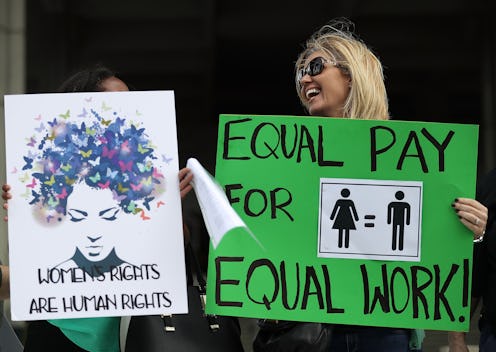
The most common issue that comes up when we discuss wage inequality is gender. But it's also an issue of race, sexual orientation, and many other aspects of identity, according to Hired's "Women, Work, And The State Of Wage Inequality" report in honor of Equal Pay Day. And as intersectional feminists, we need to take all these problems into consideration when we talk about the wage gap and how to close it.
While women experience a number of disadvantages in our society, including less pay than men, men and women are not the only two genders, and non-binary people are also marginalized in many ways. Plus, regardless of gender, people experience privilege and oppression based on other groups they belong to. People who belong to multiple oppressed groups tend to have an even harder time, and as you'll see, that applies when we look at economic inequality.
To identify these intersecting patterns, Hired, an online career marketplace, analyzed data on job offers made through its platform. While the study looked in particular at gender, race, and LGBTQ people, it's also worth noting that people with disabilities, mothers, and older women also make less money. That said, here are three forms of wage inequality Hired's study found.
Gender
The difference between the salary offers women and men on Hired received for the same jobs at the same companies was a little less than you'd expect given the fact that women make 78 cents for every dollar men earn: Women received offers four percent lower than men's on average. But their offers were at least slightly lower 63 percent of the time (a slight improvement over last year's 69 percent), and sometimes they were as much as 50 percent lower. One in 10 jobs paid 20 percent higher or more for men.
There was one encouraging bit, though: Women actually made $1.08 for every dollar men earned less than a year into their careers, likely because they were asking for four percent more on average. But women began to make less around six years in, which the report suggests could be related to the "motherhood penalty" — lower pay for women with children.
Race
Of all the demographics Hired studied, white men earned the most and black women earned the least, with a 21 percent salary difference between these groups. (Nationally, there appears to be a larger wage gap for black women: They make 63 percent of what white men do, according to the National Women’s Law Center.) Asian and Latina women also made less than white women. Though men all made more than women of their own race, race trumped gender in one instance: White women earned more than black men. However, these numbers could be a little off because Hired didn't study black and Latinx men and women individually; they got the results by combining the effects of the race gap and the gender gap.
LGBTQ Status
Sexual orientation and gender identity also affected earnings, with LGBTQ women and men earning less than their straight, cis counterparts. This is a bit different from previous findings. A Williams Institute analysis found that gay men make 10-32 percent less than straight men, but lesbians make more than straight women. A 2015 University of Melborne study similarly found that gay men made 18 percent less than straight men in Australia, while lesbians made more than straight women, likely because they less often had children.
All these findings put together show that our pay is affected not just by our gender but also by our race, sexual orientation, and gender identity — yet another reason feminists need to keep fighting for all oppressed groups.